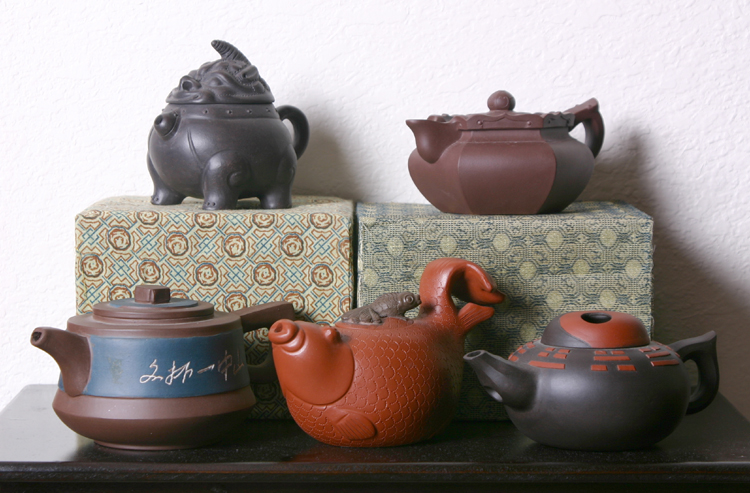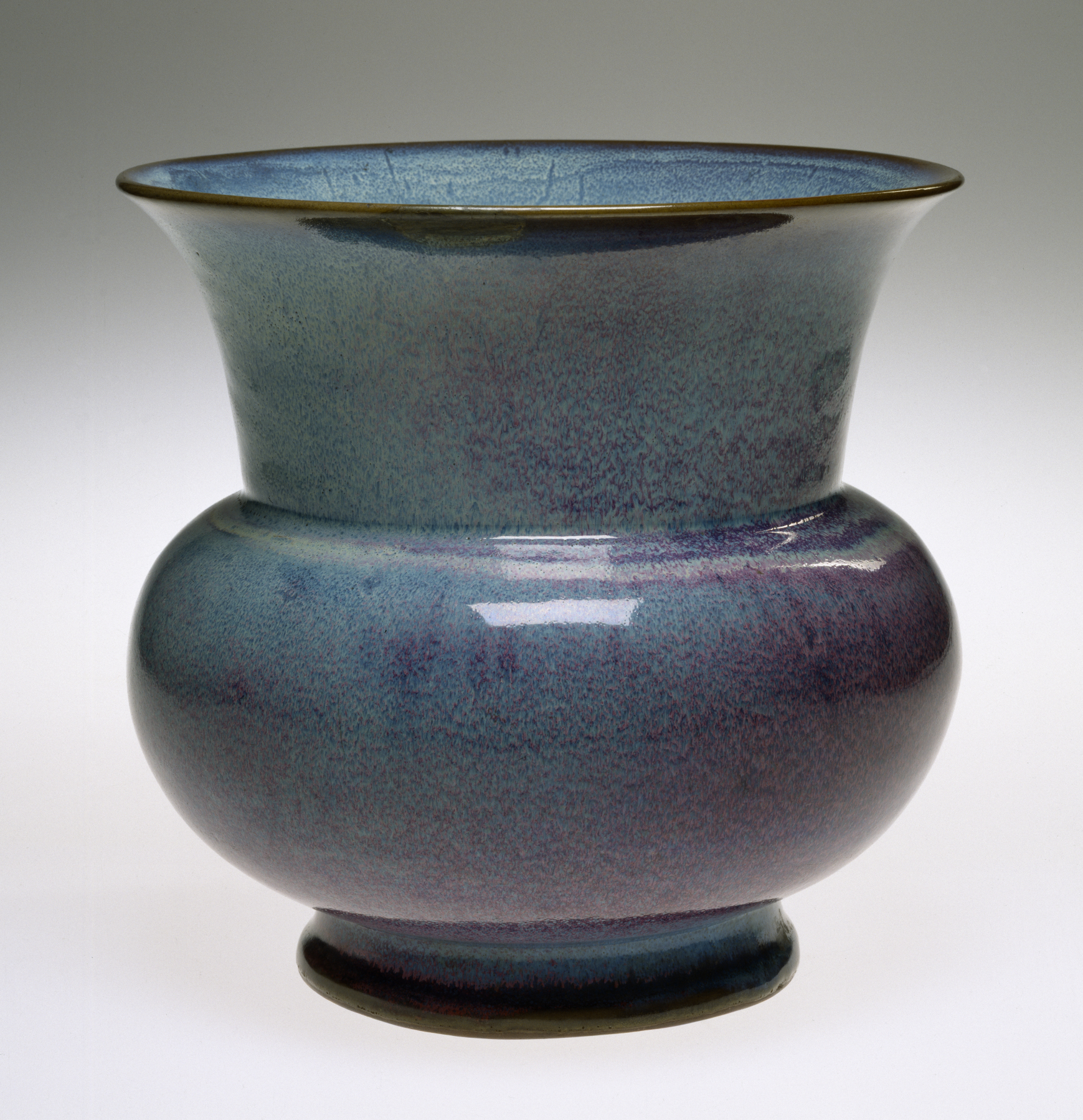|
Ge Mingxiang
Ge Mingxiang (1736–1795) () was a Chinese potter born in Dingshan, Yixing and active during the Qianlong period. Works by him and his brother Ge Yuanxiang () were classified as Yixing ware Yixing clay ( zh, s=宜兴泥, t=宜興泥, p=Yíxīng ní, w=I-Hsing ni) is a type of clay from the region near the city of Yixing in Jiangsu Province, China, used in Chinese pottery since the Song dynasty (960–1279) when Yixing clay was fi .... The two brothers also made Yijun ware (imitations of Jun glaze) with mottled blue and green glazes (often referred to as "robins egg glaze"). Their work often took an egg-shaped or baluster form. Their work was well received both domestically and overseas, especially in Japan. Later generations continued to use the seal of the two brothers through the early 20th century. Museum holdings Their work is held by several institutions, including: * Philadelphia Museum of Art, Accession no.1904-629 * Victoria and Albert Museum, Accession no. ... [...More Info...] [...Related Items...] OR: [Wikipedia] [Google] [Baidu] |
Yixing
Yixing () is a county-level city administered under the prefecture-level city of Wuxi in southern Jiangsu province, China, and is part of the Yangtze Delta, Yangtze River Delta. The city is known for its traditional Yixing ware, Yixing clay ware tea pots. It is a pene-exclave with Changzhou. The city spans an area of , and has a registered hukou population of about 1,075,800 as of 2020. History During the Xia dynasty and Shang dynasty, the area fell under the jurisdiction of Yangzhou and was known as Jingxi (). The area was subsequently known as Jingyi () during the Zhou dynasty. The area was first organized as a Counties of China, county in 221 BCE, during the Qin dynasty, under the name of Yangxian County (). Between 303 and 310 CE, local general Zhou Qi (Jin dynasty), Zhou Qi, a son of General Zhou Chu, suppressed three rebellions. Yangxian County was then renamed Yixing Commandery (), in honor of Zhou Qi. Yixing Commandery remained under the jurisdiction of Yangzhou. In 589 C ... [...More Info...] [...Related Items...] OR: [Wikipedia] [Google] [Baidu] |
Qianlong Emperor
The Qianlong Emperor (25 September 17117 February 1799), also known by his temple name Emperor Gaozong of Qing, personal name Hongli, was the fifth Emperor of China, emperor of the Qing dynasty and the fourth Qing emperor to rule over China proper. He reigned officially from 1735 until his abdication in 1796, but retained ultimate power subsequently until his death in 1799, making him one of the longest-reigning monarchs in history as well as one of the longest-lived. The fourth and favourite son of the Yongzheng Emperor, Qianlong ascended the throne in 1735. A highly ambitious military leader, he led Ten Great Campaigns, a series of campaigns into Inner Asia, Burma, Nepal and Vietnam and suppressed rebellions in Jinchuan County, Jinchuan and Taiwan. During his lifetime, he was given the deified title Emperor Manjushri by the Qing's Tibetan subjects. Domestically, Qianlong was a major patron of the arts as well as a prolific writer. He sponsored the compilation of the ''Siku Qu ... [...More Info...] [...Related Items...] OR: [Wikipedia] [Google] [Baidu] |
Yixing Ware
Yixing clay ( zh, s=宜兴泥, t=宜興泥, p=Yíxīng ní, w=I-Hsing ni) is a type of clay from the region near the city of Yixing in Jiangsu Province, China, used in Chinese pottery since the Song dynasty (960–1279) when Yixing clay was first mined around China's Lake Tai. From the 17th century on, Yixing wares were commonly exported to Europe. The finished stoneware, which is used for teaware and other small items, is usually red or brown in colour. Also known as zisha ( zh, c=宜興紫砂, labels=no) ware, they are typically left unglazed and use clays that are very cohesive and can form coils, slabs and most commonly slip casts. These clays can also be formed by throwing. The best known wares made from Yixing clay are Yixing clay teapots, tea pets, and other teaware. Clay types Zisha can be broadly categorised into three colours: purple, red and beige. The deeper the colour the higher the concentration of iron in the clay. *''Purple: Zi sha'' or ''zi ni'' ( or ... [...More Info...] [...Related Items...] OR: [Wikipedia] [Google] [Baidu] |
Jun Ware
Jun ware () is a type of Chinese pottery, one of the Five Great Kilns of Song dynasty ceramics. Despite its fame, much about Jun ware remains unclear, and the subject of arguments among experts. Several different types of pottery are covered by the term, produced over several centuries and in several places, during the Northern Song dynasty (960–1127), Jin dynasty (1115–1234) and Yuan dynasty (1271–1368), and (as has become clearer in recent years) lasting into the early Ming dynasty (1368–1644). Some of the wares were for a popular market, especially the drinking vessels, but others seem to have been made for the imperial court and are known as "official Jun wares"; they are not mentioned in contemporary documents and their dating remains somewhat controversial. These are mostly bowls for growing bulbs or flower-pots with matching stands, such as can be seen in many paintings of scenes in imperial palaces. The consensus that seems to be emerging, driven largely by th ... [...More Info...] [...Related Items...] OR: [Wikipedia] [Google] [Baidu] |
Baluster
A baluster () is an upright support, often a vertical moulded shaft, square, or lathe-turned form found in stairways, parapets, and other architectural features. In furniture construction it is known as a spindle. Common materials used in its construction are wood, stone, and less frequently metal and ceramic. A group of balusters supporting a guard railing, coping, or ornamental detail is known as a balustrade. The term baluster shaft is used to describe forms such as a candlestick, upright furniture support, and the stem of a brass chandelier. The term banister (also bannister) refers to a baluster or to the system of balusters and handrail of a stairway. It may be used to include its supporting structures, such as a supporting newel post. In the UK, there are different height requirements for domestic and commercial balustrades, as outlined in Approved Document K. Etymology According to the ''Oxford English Dictionary'', "baluster" is derived through the , from , from ' ... [...More Info...] [...Related Items...] OR: [Wikipedia] [Google] [Baidu] |
Potters
A potter is someone who makes pottery. Potter may also refer to: Places United States *Potter, originally a section on the Alaska Railroad, currently a neighborhood of Anchorage, Alaska, US * Potter, Arkansas * Potter, Nebraska * Potters, New Jersey *Potter, New York * Potter, Wisconsin *Potter County, Pennsylvania * Potter County, South Dakota *Potter County, Texas * Potter Lake, Wisconsin * Potter Township (other) *Potter Valley, California ** Potter Valley AVA, California wine region in Mendocino County * Potter Cemetery, Michigan Elsewhere * 7320 Potter, an asteroid * Potter Island, Nunavut, Canada *Potter Peninsula, South Shetland Islands People and fictional characters *Potter (name), a given name and a surname, including a list of people and fictional characters with the name Arts, entertainment, and media * ''Potter'' (TV series), a TV sitcom starring Arthur Lowe *Harry and the Potters, an American rock band * ''Harry Potter'', worldwide bestselling book and fi ... [...More Info...] [...Related Items...] OR: [Wikipedia] [Google] [Baidu] |
Chinese Artists
Chinese may refer to: * Something related to China * Chinese people, people identified with China, through nationality, citizenship, and/or ethnicity **Han Chinese, East Asian ethnic group native to China. **''Zhonghua minzu'', the supra-ethnic concept of the Chinese nation ** List of ethnic groups in China, people of various ethnicities in contemporary China ** Ethnic minorities in China, people of non-Han Chinese ethnicities in modern China ** Ethnic groups in Chinese history, people of various ethnicities in historical China ** Nationals of the People's Republic of China ** Nationals of the Republic of China ** Overseas Chinese, Chinese people residing outside the territories of mainland China, Hong Kong, Macau, and Taiwan * Sinitic languages, the major branch of the Sino-Tibetan language family ** Chinese language, a group of related languages spoken predominantly in China, sharing a written script (Chinese characters in traditional and simplified forms) *** Standard Chines ... [...More Info...] [...Related Items...] OR: [Wikipedia] [Google] [Baidu] |
18th-century Chinese Artists
The 18th century lasted from 1 January 1701 (represented by the Roman numerals MDCCI) to 31 December 1800 (MDCCC). During the 18th century, elements of Enlightenment thinking culminated in the Atlantic Revolutions. Revolutions began to challenge the legitimacy of monarchical and aristocratic power structures. The Industrial Revolution began mid-century, leading to radical changes in human society and the environment. The European colonization of the Americas and other parts of the world intensified and associated mass migrations of people grew in size as part of the Age of Sail. During the century, slave trading expanded across the shores of the Atlantic Ocean, while declining in Russia and China. Western historians have occasionally defined the 18th century otherwise for the purposes of their work. For example, the "short" 18th century may be defined as 1715–1789, denoting the period of time between the death of Louis XIV of France and the start of the French Revolution ... [...More Info...] [...Related Items...] OR: [Wikipedia] [Google] [Baidu] |




